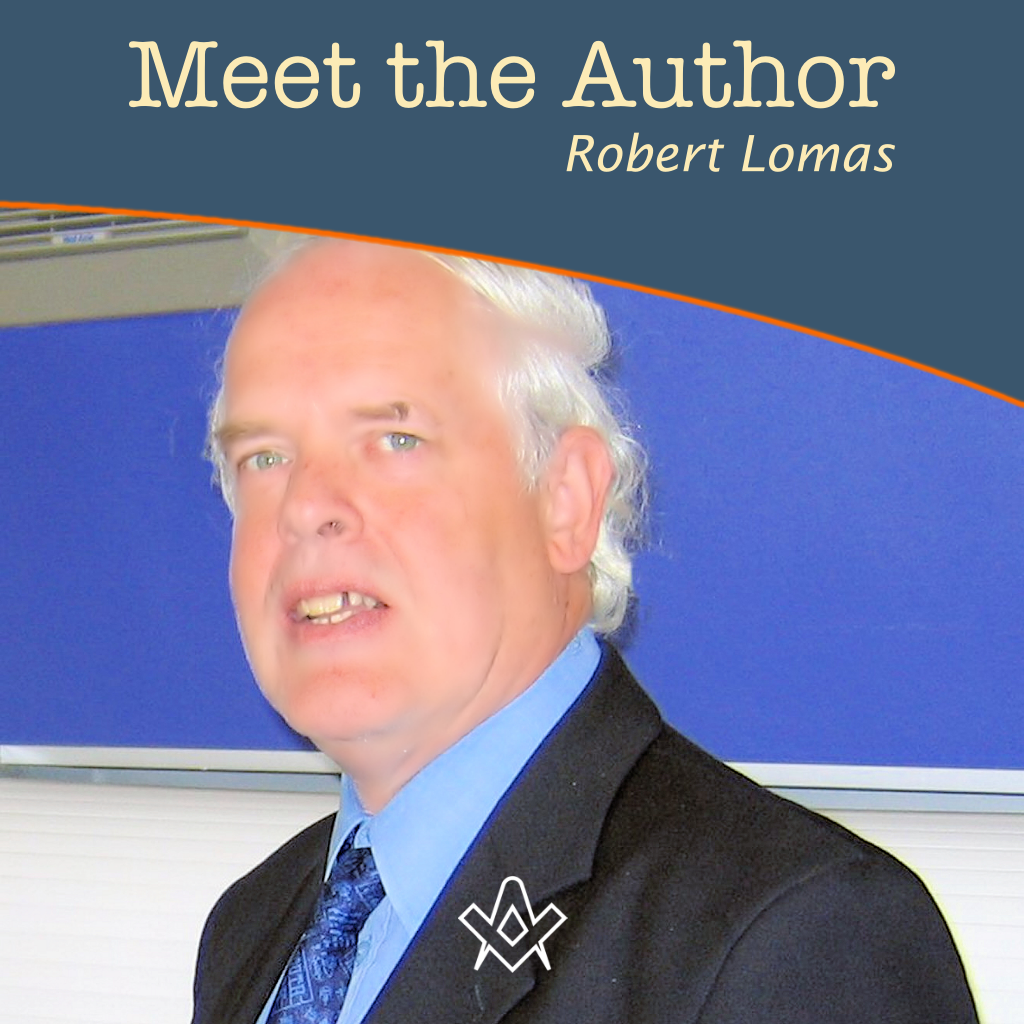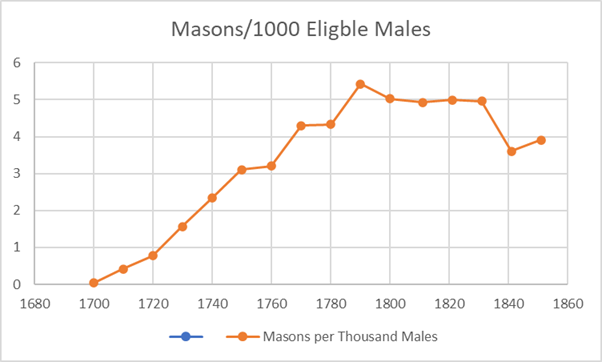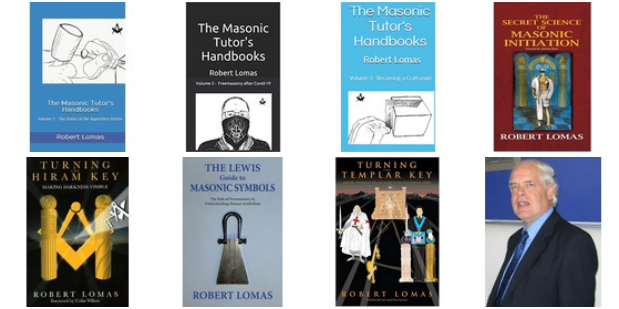Robert Lomas has a BSc (First Class Honours) in Electronics and a PhD in the Quantum Physics of Solid State Devices.
Ferranti Military Systems first employed him to work on Cruise Missile guidance systems, computer microchip development, destroyer weapons control systems and Fire Brigade response systems.
He then spent over thirty years as a university lecturer and IT consultant, during which time he became a national expert on Fire Brigade Command and Control Systems, developed the first computer based Fire Training system and set up the Fire Information National Data System for the Chief Fire Officers Association.
He became a Freemason in 1987 and applied his research training to understanding Freemasonry, as nobody seemed willing or able to explain it to him.
He undertook his own investigations and eventually co-authored the international best seller ‘The Hiram Key’.
Since then Robert has written twenty-six further books on Freemasonry as well as scientific biographies, textbooks, translations, and academic papers.
Robert’s writings have been translated into 54 different languages.
He recently wrote a comic book, a graphic illustrated introduction to Freemasonry entitled ‘Freemasonry for Beginners’, targeted at young people of college age.
The book was published by the Boston Publishing Group, For Beginners Inc.
Robert has a long-time interest in Masonic Education and for the last 24 years has been a regular lecturer on Masonic topics at lodges throughout the UK as well as abroad.
In May of 2020, he published the first of a series of Masonic Tutor’s Handbooks in conjunction with Lewis Masonic.
During the lockdown in British Freemasonry he set up a Podcast Initiative to provide lodges with Masonic material to use, while they could not meet and has also published this current Masonic Tutor’s Handbook on responding to Covid..
He is a retired Fellow in Operations Management of Bradford University where he still curates the web-based Masonic source site www.webofhiram.org which he set up twenty-two years ago featuring works from the University’s special collections.
Robert has other interests outside Freemasonry which include building and sailing model boats and translating the works of the Victorian Welsh novelist Daniel Owen.
So far, he has published English translations of the Welsh novel ‘Rhys Lewis’, and a melodramatic serial ‘Ten Nights in the Black Lion’ which he launched at the 2020 online Daniel Owen Festival.
He is presently working on translating ‘Sketches of Methodist Characters’.
He has also published a book of Welsh based fairy tales he wrote and illustrated for his children entitled ‘The Pant Glas Children’.
He is also organist in three lodges, Living Stones 4957, Excelsior Lodge 4641 and Monarch Lodge 3381

PL: This month in ‘Meet the Author’ we are delighted to welcome the Masonic author Dr Robert Lomas.
I’m sure many of our readers are familiar with your books, and you have written an amazing amount.
I must admit I am a big fan of one of your non-Masonic ones – The Man Who Invented the Twentieth Century – a heartfelt retelling of the triumphs and tragedies of an unsung hero of science; the genius Nikola Tesla.
However, primarily I’d like to talk to you about your latest book, because it is a crucially important one to be talking about right now.
You have a new series ‘The Masonic Tutor’s Handbooks’. Volume 2 in the series is ‘Freemasonry after Covid-19’: A Guide to Help Your Lodge Recover After the Covid-19 Pandemic.’
A succinct and to-the-point title – just what is needed in the current circumstances.
Freemasonry has evidently been having trouble pre-Covid –but I think the main question everyone is at least thinking, if not asking, is ‘how is Freemasonry going to recover after over a year of being ‘dark’.
You dive in straight away with the chapter heading – ‘The existential threat of Covid-19’ and you use the analogy that Freemasonry has ‘taken part in a dangerous and compulsory experiment’ and been placed ‘in an artificially induced coma’.
This state of enforced inertia has raised many questions as to the future of the fraternity; will it have lost the ‘cement that binds it’ and more crucially, will it have lost its members?
2020-2021 has seen the entire world contend with an unprecedented situation, and recovery is going to take some time.
However, I really like the way you describe the process of awakening the Craft; ‘Now with the advent of vaccines, we must face the risky business of arousing this slumbering giant.’
I wonder, will the giant survive being taken off the ventilator and regain its strength, will ‘Long Covid’ set in, causing intractable chronic fatigue?
Or has the pandemic just accelerated a problem that has been eroding the Craft for a long time?
How do you think members are feeling right now with not having been to Lodge for over a year – how has it affected them socially, emotionally, and financially?
RL: I think that the Covid lockdown has exacerbated a problem which has been apparent since the early noughties.
There were already many lodges struggling to survive before the pandemic.
For many years I have undertaken a programme of Masonic education to try and attract new Candidates and improve the retention of existing ones.
The problem is a mismatch between our infrastructure (i.e. number of lodges and number of halls) and the size of the membership who have to fund the cost of running the venues.
For over a year we have been unable to bring in new members and have been steadily losing older members to the Grand Lodge Above for many reasons as well as Covid.
It’s been a double whammy for the Craft, our younger members have been struggling with home-schooling, furloughing and working from home combined with worrying about the future of their jobs.
Older members, many of whom are retired and on reliable pensions, have been most at threat of infection and death if they try to meet.
As a direct result we have all lost the habit of attending lodge, forgotten how to deliver ritual, and lost interest in video meetings which are no substitute for real meetings where individual conversations take place over a convivial meal.
Video meetings are like trying to hold a private conversation in a hall of listeners, using megaphones.
Small wonder attendance drops off and individuals keep in touch by phone instead.
I decided within the first few weeks of lockdown, when I had cancel a lot of planned lectures, that a way forward would be to create free-standing radio broadcasts (podcasts) of the lectures which could be emailed to brethren who wanted to hear the talk.
By restricting distribution to known brethren, who had previously agreed to keep the podcasts confidential, I was able to deliver material which would normally be tyled and secure.
This has proved to be popular and has also provided topics for discussion to give video meetings more Masonic focus.
I didn’t find the alternative of producing public talks for YouTube attractive, as the topics that could be addressed are severely limited and the distribution cannot be contained.
I have done a few webinars, but not on ritual subjects, simply on the impact of Covid on Freemasonry.
This book is one outcome of those sessions and the discussions my statistical analysis provoked.
I think that we are likely to lose quite few lodges and Masonic halls which will find they are unable to return to normal, or that number-limited, socially-distanced meetings without a festive board are not an attractive proposition.
If a hall has lost its caterers during lockdown and found its kitchens have to be modified to meet any ongoing Covid restrictions before it can appoint new ones, then it may not be possible to have festive boards.
Returning to lodge without them could well encourage some brethren to defer their return.
As we may not have enough active members to officer all our lodges, perhaps we might have to consolidate.
If lodges have to return their warrants, then brethren who become unattached should carefully consider which lodges have the best chance of surviving and consider joining them to help their revival.
PL: The next chapter ‘Our Problems Before Covid-19’ really highlights how things have changed within Freemasonry since the end of WWI.
Your studies and the ensuing statistics into the rise and fall of the Craft are fascinating, and eye-opening, it makes quite sobering reading.
You coined the phrase ‘Peak Masonry’ – could you tell us more about that, and those three factors that contributed to the sudden decline at the end of the 1980s/early 90s?
RL: Since the formation of the Grand Lodge of London in 1717, Freemasonry has steadily grown in popularity, brethren and number of lodges. In general daughter lodges were formed when existing lodges had too many members to permit all brethren to proceed up the officers’ ladder to the chair within a reasonable time. Here is chart of the popularity of Freemasonry over this time expressed as number of Masons per 1000 eligible males in the population in England and Wales.
The period around the creation of ULGE by merging the Antients and the Moderns impacted on our popularity, which had peaked during the competition between the two grand lodges.
There was a lot if discontent during the forced amalgamation when the Royal Arch and Mark, which had been part of the Craft for the Antients, were split off into separate grand lodges by the victorious Moderns.
From 1840 onwards until the early 1990s, the story of Freemasonry was one of continuous growth in popularity.
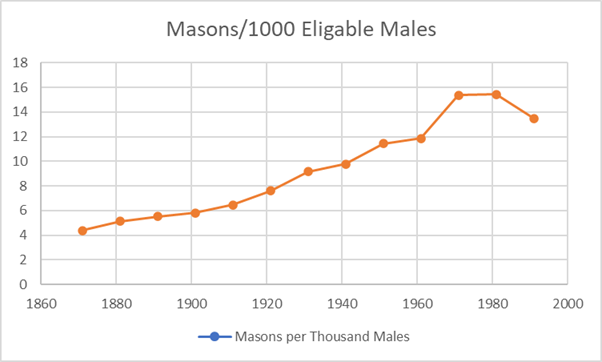
This pattern of increasing popularity lead to steady growth in the number of Masons and a subsequent growth in the number of lodges and Masonic halls to house them.
From 1860 until 1990 the ‘Rulers’ of Freemasonry only had to manage growth.
Then membership fell off a cliff edge over about five years, before stabilising into a less dramatic decline in mid-1990 (there is a full analysis in the book)
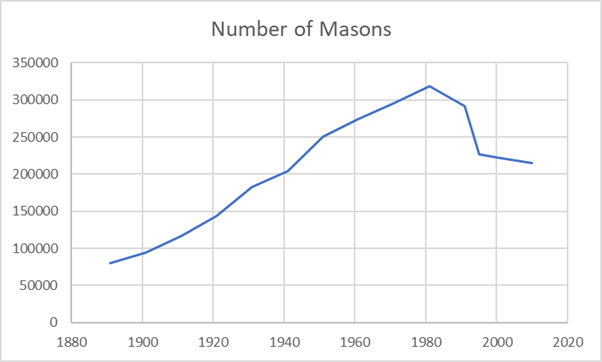
Until the late 1980s ULGE was pretty good at controlling its media profile and managed to maintain a good public image, it was generally portrayed as an Order for the great and good which accepted all good men and true, and could make a humble grocers and loyal ex-servicemen, brothers to Royalty.
However, this changed in 1988, when Stephen Knight published The Brotherhood. He accused us of being a corrupt network of self-seeking devil worshippers who had been infiltrated by the KGB.
In 1994, Martin Short published a follow up book, entitled Inside the Brotherhood, which portrayed us as a shady group who could ‘make or break men’s careers and have shattering impact on marriage and family’.
Short suggested we controlled the Police and the Law Courts and were a taking part in systematic corruption of public life.
These books were taken so serious by Labour MP Chris Mullen, who at the time was Chair of Home Affairs Select Committee, he conducted a serious campaign to make membership of Freemasonry illegal for some professions.
Higham, the then Grand Sec. of UGLE, was called to testify before Mullen’s committee and only just escaped being held in contempt of Parliament when he refused to demonstrate our ‘secret handshake’.
At that time, we lost many professional members and potential Candidates, as joining Freemasonry became seen as a career limiting choice, for the first time in our history.
PL: You published The Hiram Key: Pharaohs, Freemasonry, and the Discovery of the Secret Scrolls of Jesus (co-authored with Christopher Knight) in 1995.
This was the first of the alternative Masonic history genre that became popular in the years after and it certainly created quite a stir within the Church, and Freemasonry.
But you say that this book actually helped regain members after the ‘crash’ of 1991 – how do you feel it contributed to the increase in membership, and why?
RL: When Chris and I decided to write The Hiram Key we were well aware of the poor public press, indeed as a working academic I questioned whether I wanted to stay in the Craft.
However, I had become fascinated with the odd secrets which were imparted to Master Masons.
These were such an odd mix of scientific encouragement, tales of self-improvement and character building, combined with encouragement to seek a weird mystical experience called ‘awareness of the centre’.
That spiritual experience is central to all the great religions of the world, and when I realised this I decided there had to be more to Freemasonry than a peculiar system of morality.
Its study of symbols as tools to investigate the hidden mysteries of nature and science, suggested that its philosophical secrets were real and offered tremendous lessons of personal insight to anyone who took them seriously.
However, when we wrote The Hiram Key, Chris and I did not realise that Freemasonry has two histories, a mythical history which stretches back to Adam, and a mundane history which I have since been able to trace back to Aberdeen in the 1480s.
It took me years to disentangle them, and I have since written about both separately.
The Hiram Key has been an international bestseller and is still popular.
I am constantly humbled by the number of Masons I meet who tell me that it was that book that encouraged them to join Freemasonry.
Despite the unremitting hostility of UGLE towards it, and their systematic attempts to undermine both Chris and myself, and to drive us out of the Craft, that book still managed to change the public perception of Freemasonry.
Freemasons were no longer seen as self-seeking corrupters of public morals but became Guardians of Ancient Knowledge about character building, and scientific, and social, innovation.
This change of attitude was consolidated by the books it inspired, not least The Da Vinci Code, which picked up and reinforced its message.
The evidence can be seen in the way the disastrous decline of membership levelled off as the positive message of The Hiram Key started to counter the negative attitudes of The Brotherhood and Inside the Brotherhood (see above graph of number of Masons).
The difference was that Chris and I thought that Freemasonry had worthwhile secrets, and wrote a book about how it was worth preserving.
We encouraged interested individuals to become a part of it.
We wrote the first ever best-selling book in the whole history of the Craft, and so put that positive message before the general public.
It was certainly popular, as it remained near the top of the Sunday Times Best Seller list for months.
PL: In the next chapter ‘How Can We Monitor Our Progress’, you get down to practical solutions.
You come up with the ingenious ‘F’ Number – a play on the ubiquitous ‘R’ number that we have all become familiar with during the Covid 19 pandemic news reports.
Can you explain how the ‘F’ number can be applied?
RL: Like everyone else I have been watching Chris Whitty and his expositions about infection rate and the spread of disease.
A key feature of the R Number is that if it is above 1 the infection spreads exponentially, and it if is below 1 infection dies away.
My F number is easy to calculate at each year end. Take the number of Master Mason Certificates issued and divide it by the number of lodges (statistics published each year by UGLE).
If each lodge has at least 1 new MM each year then it can populate its ladder and survive.
If the number drops below 1 then some lodges are struggling and have to recycle Past Masters to stay alive.
This statistic can be calculated for Provinces, and even groups of lodges sharing a Masonic Hall and it gives an independent and instant measure of the health of that section of the Craft.
When I applied this statistical measure to our past performance, I discovered that immediately after WWI the F number was 20.
This completely explains the rapid growth in lodges. However, in recent years the situation has changed.
Here is a close up of the F number since the 1990s.
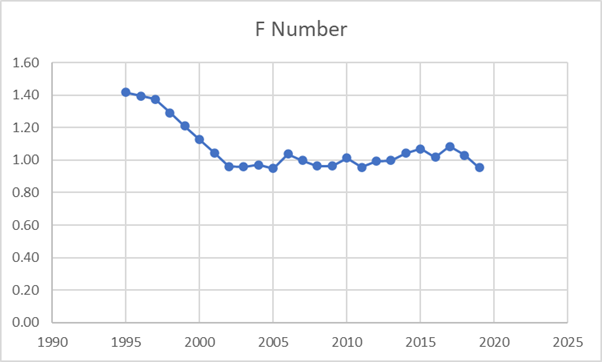
Since the turn of the millennium the F number has become critical.
We started the 2000s with an F number of 1.13 which was low but not disastrous.
By 2002, the F number fell below 1 for the first time in our history (see full analysis in book) when it hit 0.96.
Up to the onset of lockdown we were hovering around 1, with more incidences below 1 than above. We either have too many lodges, or not enough candidates.
And after a year of no initiations and many of our more experienced brethren moving on to the Grand Lodge Above, we have certainly have a problem.
The question then becomes what do we do about it?
PL: You have lectured widely and prolifically for many years and first published the results of your studies in 2012, in A Miscellany of Masonic Essays.
Essay number 16 is entitled ‘What Should Freemasonry Do’, so you have long been trying to engage brethren with the problems of declining memberships, lodge apathy, and giving some possible solutions.
But it is your passion for the ‘Masonic Study of Truth’ that is a driving force, is that right?
Do you feel that Freemasonry has lost its perspective and become too much of a charitable organisation with fine dining?
Perhaps less is more – fewer lodges and members with more of a focus on the true nature of Freemasonry would be the way to go – more advancement in Masonic knowledge, fellowship, and of course, the pursuit of self-knowledge through the moral teachings of the Craft?
RL: I agree with almost all the sentiment you express in the question, but I would add that it is the pursuit of self-knowledge through the philosophical and moral teachings which offer us a way forward.
As you have seen in my analysis of the nature of membership of the Craft since the early eighteenth century until the end of WWI, we drew our membership from individuals interested in self-development and the peculiar esoteric and philosophical insights of the Craft.
This is firmly based in the three original principles of Brotherly Love, Relief, and Truth.
The influx of war-damaged ex-servicemen after WWI was mainly driven by an urge to seek the Brotherly Love and structure they had experienced from service during the horrors of war.
The rapid increase in lodges diluted the traditional way of teaching as individuals were pushed rapidly through the degrees.
This continued until the great crash of the 1990s. For example, when I was initiated in 1987, I was pushed through all three degrees, in three meetings spread over three months.
It took me ten years to begin to understand the secrets of those degrees, and I had to work it out for myself as nobody was either willing or able to answer my questions.
There are lots of other organisations which offer Integrity, Respect and Friendship (i.e. some limited aspects of Brotherly Love) that are cheaper to join, offer more fulfilment and finer dining, but don’t demand the discipline of learning and delivering ritual.
There are also many charities which you can support without having to buy an apron, a case to keep it in, and commit to regularly sitting in a darkened room with an assortment of ritual-spouting oddballs.
I find it sad that ULGE seems to think that it represents nothing more than a Chummy Charity.
Freemasonry, in its long history has always prided itself in its study of Truth.
This inspired our ancient brethren to create the Royal Society, the American Constitution, the Institute of Civil Engineers and the Institute of Mechanical Engineers, and that is without mentioning the establishment of the Halifax Building Society by the brethren of the Lodge of Probity.
Freemasonry has survived and thrived for so long because it has understood what it had to offer.
That offering is more than Brotherly Love, more than Relief, it also encompasses the inspirational study of Truth and purpose of Life.
If we reduce what we offer our Candidates to Integrity, Respect, Friendship, and Charity, we are not just likely to die out – we will deserve to.
PL: The last part of the book is concerned with ‘Tactical Responses to Lockdown’, ‘Techniques for Short-term Survival’, and your final thoughts on the subject.
Perhaps you could explain your ideas / theories in brief – and then readers can buy the book to find out more!
RL: Freemasonry is a unique survival of an ancient tradition of self-help and personal development.
It has been a longstanding puzzle for me how group of illiterate stone masons, who were building the magnificent, towering, structure of St Nickolas’s Kirk in Aberdeen came up with the wonderful idea of awareness of the centre, let alone the study of Truth.
Perhaps one day I will be able to discover how they were inspired, and if I do, I will share that knowledge.
But until then let me quote the words of by Bro Hyneman, from 1872.
He was writing long before the events of the twentieth century and he articulates what Freemasonry represented to its adherents and what I think we should aspire to again.
No other long-standing Fraternal Order offers to its Candidates Initiation into the Ancient Secrets of the Study of Truth.
We are unique, we are more than a dining club, we are more than a charity, we have been Initiated to become Guardians of Ancient Truths about the human condition.
We should make greater efforts to understand what we have, and how we can pass it on, unsullied, to our children.
I leave the last words to Bro Hyneman.
‘The principles of Masonry are practical and founded upon the basis illustrated by the Supreme Being in the phenomenal manifestations of nature, the universal exemplar through which God teaches all human life the mode and manner of his government.
All aims are only valuable as they are useful.
To be employed in uses should be man’s aim in individual or associative efforts.
God never intended man to be idle only in rest, to recuperate and renew his energies.
Human beings are finite, and subject to nature’s limitations, and therefore need rest.
God is infinite, and is ceaselessly at work, through the instrumentality of his laws, in unfolding phenomenal nature.
In progressive civilization, man is a co-worker with God.
In order, therefore, to be useful in promoting civilization, as God designed he should be.
He must exercise his faculties to unfold his interior perceptions.
Man can only be as useful as he is intelligent, and only in that degree.
The more intelligence he has, the greater his capacity for usefulness.
Man should therefore exercise his faculties—expand them in increasing knowledge —so that he can more ably co-operate and fulfil the design of the Creator in advancing civilization and add to the comfort and happiness of his fellow-men.
Masonry should be a great instrumentality in promoting useful knowledge and conducing to the welfare and happiness of mankind.
Such should be its aim, otherwise it is of but little use, and would only be an impediment to the world’s progress.
Departing from its original aim, from the fundamental principles upon which the system is based, Masonry would be diverted into a different channel, contrary to its intents, and subversive of its efforts in humanity’s cause.
It would no longer be a co-worker with the Great Architect in advancing humanity.’
PL: You have created a remarkable handbook; not only to address the practical issues surrounding our ‘unprecedented’ situation but also a no-nonsense, stripped to the core dressing down of how, where and when Freemasonry has gone adrift.
In just 66 pages, you may well have the blueprint for Freemasonry 2.0!
Thanks so much for sharing this with us Robert – good luck with the book, and hopefully some great changes within the Craft.
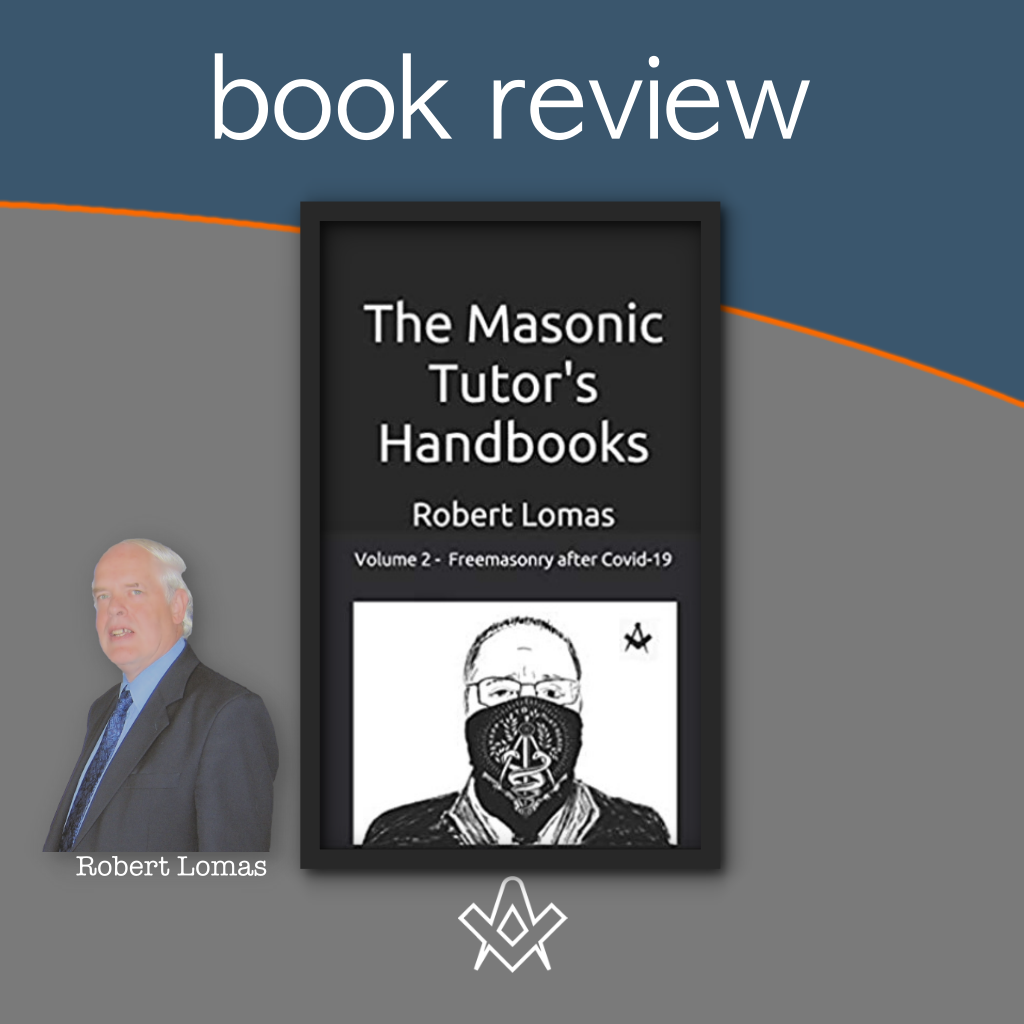
There is a review of The Masonic Tutor’s Handbooks: Volume 2 ‘Freemasonry after Covid-19’
– see here
Purchase a copy from Lewis Masonic, see link below
For more of Robert’s work visit https://www.webofhiram.org/
Article by: Philippa Lee. Editor

Philippa Lee (writes as Philippa Faulks) is the author of eight books, an editor and researcher.
Philippa was initiated into the Honourable Fraternity of Ancient Freemasons (HFAF) in 2014.
Her specialism is ancient Egypt, Freemasonry, comparative religions and social history. She has several books in progress on the subject of ancient and modern Egypt. Selection of Books Online at Amazon

The Hiram Key
By: Robert Lomas
The Hiram Key is a book that will shake the Christian world to its very roots.
When Christopher Knight and Robert Lomas, both Masons, set out to find the origins of Freemasonry they had no idea that they would find themselves unraveling the true story of Jesus and the original Jerusalem Church.
As a radically new picture of Jesus started to emerge, the authors came to the startling conclusion that the key rituals of modern Freemasonry were practiced by the early followers of Jesus as a means of initiation into their community.
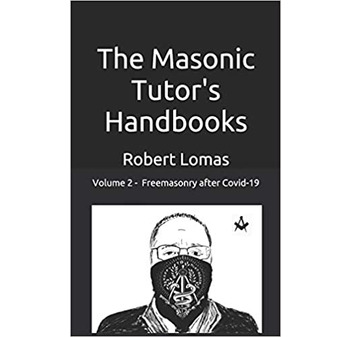
Freemasonry – After Covid 19
By: Robert Lomas
The cement which binds a lodge together is the regular meetings of its members.
For the first time ever, in our long history, we have been unable to meet. We have taken part in a dangerous and compulsory experiment.
For the first time in our long history we have had to submit Our Craft to life support by placing it in an artificially induced coma and keeping its life breath of meetings flowing by using the artificial ventilator of the video get-together.
With the advent of vaccines, we are faced with the risky business of arousing this slumbering giant.
Because of the losses by death, resignation, and decline of interest, there is a real danger that the habit of monthly Masonry in our lodges will crumble and fail. We need to do something, but what? This book explores the options for a return to a new reality.
Recent Articles: by Robert Lomas
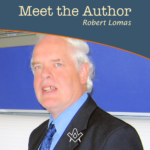
Meet The Author
Editor Philippa Lee interviews well-known Masonic author Dr Robert Lomas
more....

Book Review - The Masonic Tutor's Handbook 2
A review of The Masonic Tutor's Handbooks: Vol 2 - Freemasonry - After Covid 19 by Robert Lomas
more....
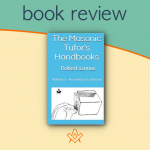
Book Review - The Masonic Tutor's Handbook 3
Becoming a Craftsman -The Masonic Tutor's Handbooks: Volume 3 - The relationship between a Fellowcraft and their Master is how the traditional wisdom of our Craft is passed on.
more....

Elias Ashmole: Masonic Hero or Scheming Chancer?
The debate is on! Two eminent Masonic scholars go head to head: Yasha Beresiner proposes that Elias Ashmole was 'a Masonic hero', whereas Robert Lomas posits that Ashmole was a 'scheming chancer'.
more....
Recent Articles: in meet the author series
 Meet The Author - Albert Mackey As a contributor to the literature and science of Freemasonry, Doctor Mackey's labours have been more extensive than those of any other in America or in Europe. |
 Philippa Lee talks Masonry and metaphysics with Ben Zion, the author of two must-have books on esoteric Freemasonry. |
 Meet The Author - Robert Freke Gould A brief look at his life, Gould was a soldier, barrister and prominent Freemason and Masonic historian. He was also one of the founders of Quatuor Coronati Lodge in 1886 |
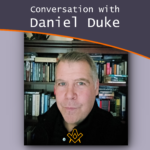 In Conversation with…Daniel Duke Author Daniel Duke talks to Philippa Lee about his new book 'Secret History of the Wild, Wild West' the third in a series on Outlaws, secret societies and hidden treasure. Dan is the great-great grandson of the infamous Jesse James, and the definitive authority on the subject. |
 Mike's Masonic Walks and Talks Mike Neville offers walks and talks primarily around London, based on his vast knowledge of the area and his specialist subjects, which cover all aspects of Masonic history, and some unique insight into the more shady side of 'Crime and the Craft'. |
 Darren Lorente-Bull is the author of 'The Other Brotherhood: When Freemasonry Crossed the English Channel' and five other books. Here he talks to Philippa Lee about his beliefs, his Freemasonry, and books. |
 Meet The Author - Angel Millar This month I am delighted to interview Angel Millar – author of five books on Freemasonry, esotericism, and world spiritual and initiatory traditions. |
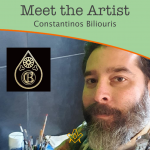 Constantinos Biliouris is a Greek Artist and brother from the Grand Lodge of Greece who creates a range of hand painted masonic aprons. |
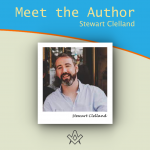 This month Editor Philippa Lee meets Stewart Clelland the author / translator of The Green Book of The Élus Coëns |
 Editor Philippa Lee interviews well-known Masonic author Dr Robert Lomas |
 This month we feature ten of our recommended Masonic authors ranging from the early 1900s to the modern day, and we offer our 'Square choice' of their books. |
 We talk with ‘Brother Hogarth’ who is currently writing a series of articles featuring the Masonic art of William Hogarth. |
 If you would like your work to be featured in The Square, please take a look at our submissions guidelines and send any ideas or contributions to the Editor for our consideration. |
 A slight deviation from our usual 'Meet the Author' theme but equally as interesting, we have a 'Portrait of an Artist' - Travis Simpkins - the man capturing the likeness of Freemasons worldwide! |
 This month we Meet the Author: historian and biographer Kevin Shillington. |
 This month in 'Meet the Author' we look at the life and work of Carl H. Claudy, a prolific Masonic author who believed that Masonic education is the foundation for the Fraternity. |
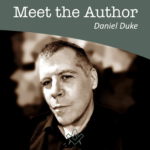 Daniel Duke, the great-great grandson of Jesse James, grew up surrounded by stories of lost outlaw treasures. |
 Stephen Dafoe - numerous books on the Knights Templar, and Morgan: The Scandal That Shook Freemasonry. |
 Paul Sparks – author of A Guide for the Masonic Treasurer |
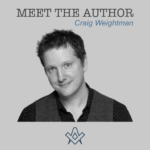 Craig Weightman – author of A Journey in Stone |
masonic knowledge
to be a better citizen of the world
share the square with two brothers

click image to open email app on mobile device



